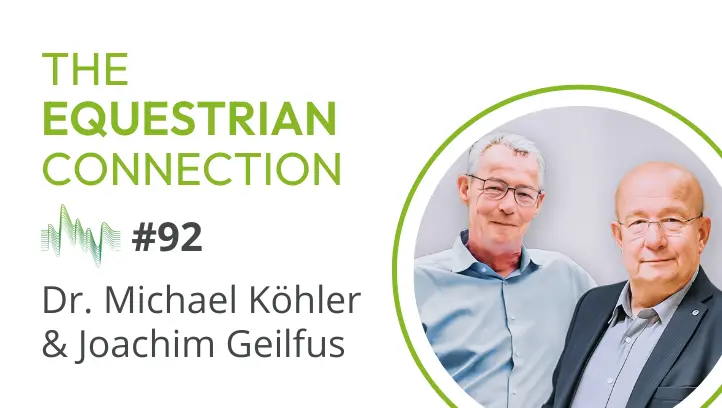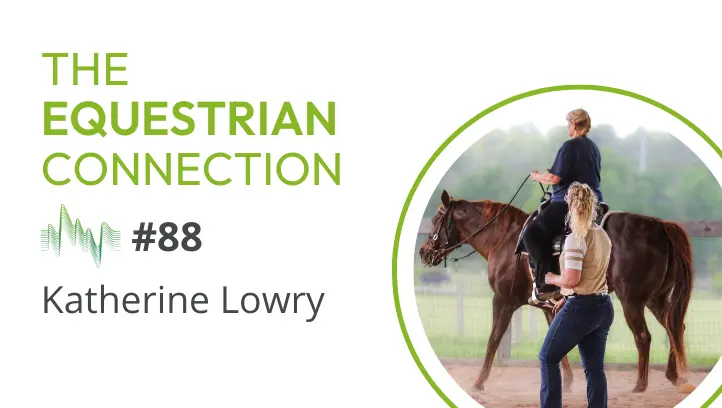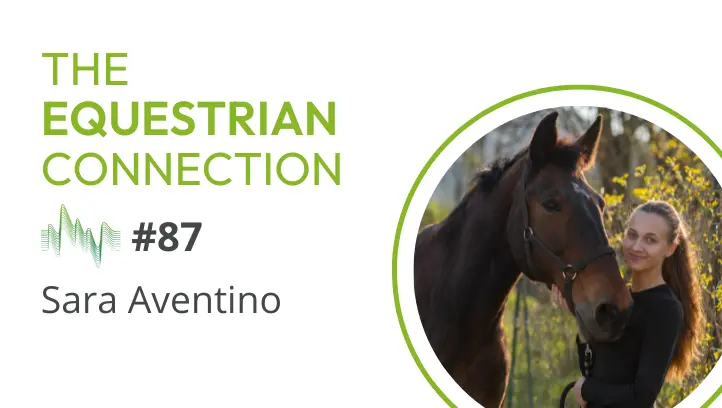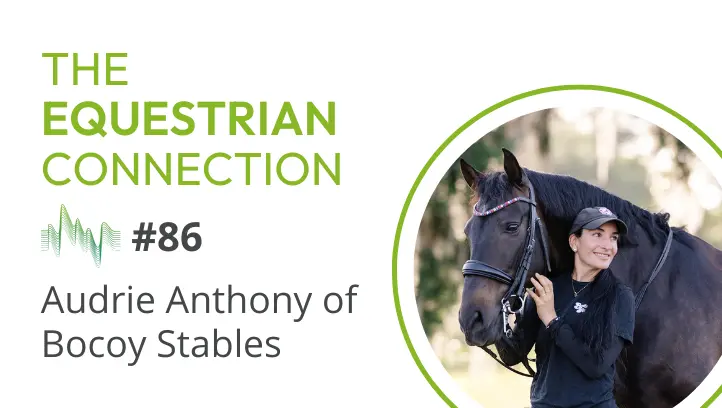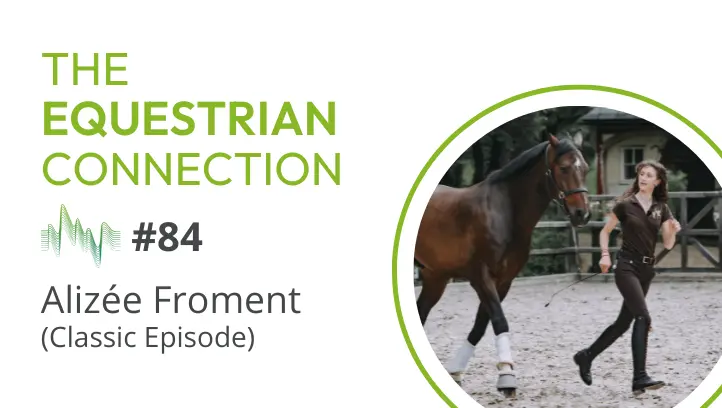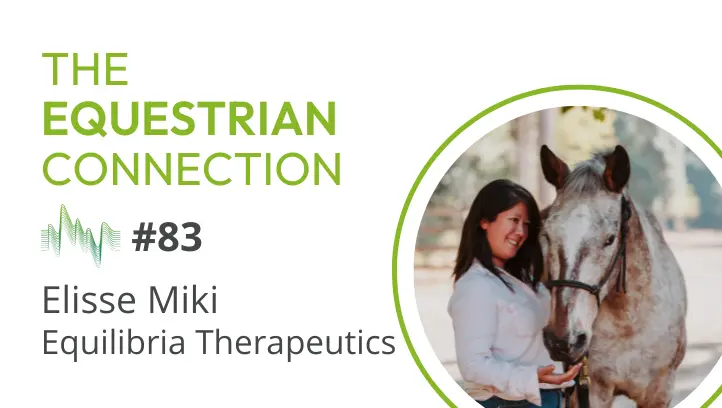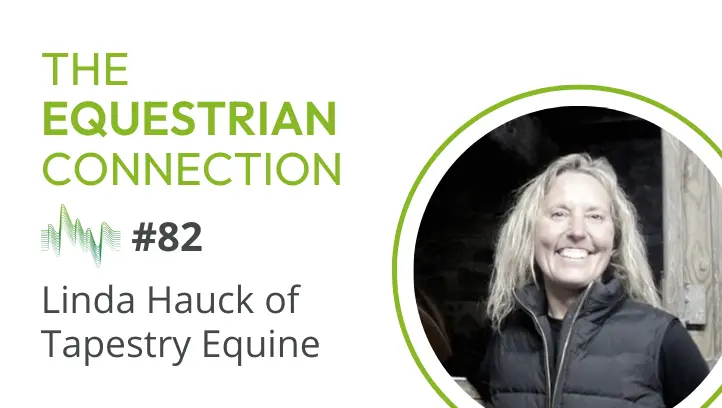#6 Cathy Woods: Pioneer in Equestrian Yoga
Cathy Woods created the unique concept “Body, Mind, Equine”. This program focuses on the use of yoga principles and posture to improve horsemanship from ground to saddle.
In the latest episode of “The Equestrian Connection,” Cathy explains that Yoga is more than one stretching exercise after another. It's a complete mindset and a way of living as it combines breathwork, meditation, and energy awareness. When Cathy has to describe Yoga in one word, it would be “Awareness.”
A decade ago, when she began to create yoga exercises for equestrians, people weren't open to that. But in our fast-moving world, people are more and more open to see how Yoga can improve their horsemanship and relationship with their horse.
This Podcast episode is really inspiring for our daily work with horses. It lets us pay more attention to the smallest signals of our horse as well as of our environment and surroundings.
Podcast Transcript
This transcript was created by an AI and has not been proofread.
This transcript was created by AI and has not been proofread
[SPEAKER 1]Hi everyone, this is the Equestrian Connection from wehorse, the online riding academy. My name is Christian Kroeber and yes, we slightly changed our name from the Equestrian Experience Podcast to the Equestrian Connection. We feature the best and most inspiring trainers, experts, horsemen and women from around the world in this podcast. I am super excited about today’s episode. because yoga has been on the rise for the past years and finally now arrived in the horse world. One of the pioneers is Kathy Woods. Based in North Carolina, she’s giving clinics and seminars nationwide and we here at wehorse very recently published a course with her on how to integrate yoga in your daily horse routine. In this podcast we talk about the beauty of yoga and the beauty of mindfulness and how it can help you get better with your horse. So let’s get things started. Hi Kathy!
[SPEAKER 2]Hi Christian!
[SPEAKER 1]Great to have you on our podcast. We are super excited to have you now on WeHorse because you do something really special and that is yoga for equestrians. I think something that evolved over the past years and you are really on the forefront, one of the pioneers of equestrian yoga. For our audience that is not so familiar with yoga, why should every equestrian do yoga or practice yoga?
[SPEAKER 2]Yes. Well, good question. I’m happy to answer that. And I want to say thank you for having me on the podcast and thank you for having me as part of WeHorse with my new course. So I’m thrilled to be here with you today and hopefully shed some light to your listeners about how yoga can improve horsemanship from ground to saddle. So your question was why we should do yoga. Well, there is a really long list and we wouldn’t have time in the whole podcast to go over everything.
[SPEAKER 1]We have a lot of time, Kathy. We have a lot of time.
[SPEAKER 2]Okay. Well, for me, it’s been what I call a life practice. So not only do I apply the principles and concepts of true yoga to my horsemanship, I try to apply that to all areas of my life. So let me start by giving the listeners a little background about yoga, because what I’ve noticed is that what I call the Americanized version of yoga is basically about the athletics, about cute, trendy yoga clothes, about catchphrases. But the true roots of yoga, which is where my practice comes from, really run a lot deeper than just the posture. So when I say yoga, I mean the whole of yoga. It is actually an eight-limbed path. There are eight aspects to yoga. Some of those limbs are breath work and different states of meditation, different stages of meditation, inward and outward observances of a yogi lifestyle. So that’s what I mean when I say yoga. I don’t just mean the posture. So given that, There are so many life benefits. I feel like if I had to use one word to describe yoga, I’d use the word awareness. It’s an awareness practice. It’s an opportunity for us to become more aware of ourselves, body, mind, spirit, energy, emotions on the yoga mat, because hopefully when we’re on the mat and we’re on the meditation cushion, we’re spending this very integrated time with ourselves. And the idea is we start to carry that more heightened, integrated, mindful awareness off the mat and into our daily lives and into our interaction with our horses, for those of us who are equestrians.
[SPEAKER 1]And I think you mentioned a couple of really valuable points, especially mindfulness and awareness. I think this has changed also in the horse world. I mean, even outside of the horse world, we come across more often, we come across those terms, mindfulness, awareness. Why do you think this has changed in the past years? What have been the drivers that people are now in the horse world more aware of themselves and also of their horses?
[SPEAKER 2]Yes, I agree. I’ve seen a lot of change over the years. I’ve basically been involved in yoga my whole life. I call myself a lifelong born yogi. So I got introduced to the practice and had interest at a very, very early age. So to me, things like awareness, raising our consciousness, mindfulness, those were all really normal terminologies for me. But yes, in our society today, those are becoming really paramount. Now, when I first introduced this concept of yoga and horsemanship well over a decade ago, you know, a lot of my trail riding friends and equine community just was not open to it. I pitched this idea to magazines and tried to get little clinics going, and there was just not the openness there. I think to answer your question, I think life, whether you’re an equestrian or a non-equestrian, is moving super fast these days. There’s so much happening in such short timeframes. Attention spans are short. Our nervous systems, I believe, are feeling fragmented and scattered. And I think these are all things that have happened in our world and our society that have caused people to say, hey, I need to level the playing field. I just can’t keep going at this warp speed. I need some tools. to help notch down my energy, to help calm and refine my nervous system. I think people are tired of living on autopilot, not being aware of what they’re doing. And yoga, meditation, these kind of mindfulness modalities are opportunities to teach people tools that they can use not just in their yoga practice, but in their daily lives.
[SPEAKER 1]How did you yourself get in touch with yoga? I mean, you have been teaching yoga now for quite some time. You are a super experienced yoga teacher yourself, but how did you yourself get in touch with yoga?
[SPEAKER 2]Interesting question. So I’ve been actually teaching 31 years. I had interest in yoga very oddly as a small child. And I do a little writing of this in my book, Yoga for Writers. I had these like interest in yoga. I don’t know where it came from. Honestly, I did not grow up in a yogic family. It wasn’t like today where yoga is all over the place on, you know, social media and magazines, it was really not a well known concept. Of course, it was in the 60s. But that was a little bit before my time. So it was probably early 70s, I would say that I started showing this kind of intuitive interest in the practice. I would do yoga postures without having to be taught them. They were very spontaneous to me. I knew there was great value to the discipline aspect of it, of holding a pose for a long period of time or staying focused on one thing. So I didn’t know it was yoga, honestly. So really my interest was before I knew that it was yoga. Now, maybe if you believe in past lives, I don’t know, Maybe I was a yogi somewhere else, but it seems… A yogi in India. A yogi in India, maybe, with a horse. So I got more formally introduced to meditation practice actually in high school in a psychology class, and it really piqued my interest that week we spent on the topic of meditation. Also during that time, I have a ballet background and I was dancing semi-professionally with a small ballet company in Florida. And I was noticing the meditation practices that I learned in school, of all places, had an impact on my dance. I was remembering my combinations better. I was more focused. My organizational skills were improved. And then fast forward a few years after that, I started taking a yoga class with a friend who was an instructor. And she had to go on vacation and asked me if I would teach the class and I did not feel qualified. But she said, you are, you’ve been teaching dance and you’re comfortable in front of a group. And, you know, yeah, teach my class. And that was kind of how I got started teaching. And then very shortly after that, I got introduced to my teacher, my guru, Yogi Amrit Desai, who is a yogi from India. And I was probably in my late teens at that point, and really dove much deeper into the full practice of yoga. And truly, it felt like coming home to actually learn yoga on these, you know, deeper levels and the philosophy behind it. So that’s a little bit about my background. And then fast forward years later, I’m a horse owner. I’m an avid trail rider. And I just started seeing like when I would go down to my barn, more mindful, more collected, more at ease, more relaxed. My whole interaction with my horses would be completely different and better on those days versus times that I went down there and I was perhaps rushed or anxious or nervous about something.
[SPEAKER 1]And I think this is a super interesting point because yoga is not only about being or having better fitness or working on core strength. It is also about those soft factors that you potentially interact differently with your environment, in this case horses, right?
[SPEAKER 2]Exactly, exactly. And horses have to be, they are a great mirror for us. So if we are operating from a nervous scattered place, they pick up on that energy and they often mirror that back to us. So it changes the relationship with our horse. I mean, simply when more science is being done about how horses can detect heartbeat and nervous system. So it makes sense that when we notch our own nervous system down and regulate our blood pressure, that our equine partners are going to have a reaction to that. Sometimes it’s a subtle reaction, sometimes it’s a bigger reaction. And then from the physicality end of it, when we’re tense and we’re walking around with tight, tense, restricted bodies, we then are restricting our horse’s movement because we’re gripping so tightly and changing our physical way that we ride versus riding in a more relaxed way. using the breath and really moving with the horse and being more present. So I’m so passionate about it, if you can’t tell, because there’s so many ways that this makes such a great pairing with horsemanship. And I’ve got to be honest here, since I’ve been doing this, I’ve seen the topic gain in popularity, which is great. And that’s what we want to see. I want to see more people using the modality and practice of yoga to improve their life and their horsemanship. but I am seeing it also take on some spins where it’s becoming about acrobatics on your horse and people barefoot doing this around horses and no helmets. And so that part makes me cringe a little bit. I’ve always been passionate about keeping yoga authentic even prior to incorporating it with horsemanship, but now incorporating it with horsemanship, I think it’s paramount that the safety issues and good horsemanship are still there. So I don’t want people to feel like applying a yogic attitude to horsemanship makes it airy-fairy or mystical in any way. It’s still a very practical approach to horsemanship. If anything, I think it’s a more mindful approach to horsemanship.
[SPEAKER 1]Before we talk about safety and how we should all keep yoga also to a certain degree safe around our horses, because as you mentioned, then some people tend not to wear helmets in difficult situations and being barefooted also a problem. But before we cover that, let’s see how it actually works in practice. Those of you of our Listeners that have seen the course with you, Cathy, on WeHorse know that yoga for riders and yoga for equestrians is not only yoga on a mat, it is also on horseback. Walk us through, Cathy, what are different postures you and I can do on the ground and on horseback?
[SPEAKER 2]Yes, I’m happy to share that. So again, there’s the whole of yoga. So how I might start a session with my horse is unmounted, perhaps standing next to the horse and doing an exercise that I call breathing with your horse. This helps us again, notch our energy down, become more grounded, more centered. And it gives us that moment to really connect with another being through breath, through energy, In yoga, we believe that prana is life force energy. So the same life force energy that’s flowing through me and you is also flowing through our horse. So by simply doing the yogic practice of breathing, standing next to your horse, maybe putting your hand on your horse’s chest or near their nostrils, and just taking a few deep mindful breaths, that would be how I would start an equestrian session on horseback. And then once we are feeling centered and grounded then mount up and mount up. And instead of like coming out of the gate task oriented, take a moment to just sit there on your horse and just feel what that feels like. And to also check in to see what head space and energy space that we’re in. I would call this on the yoga mat, like taking inner inventory. And we can do that on our horse. We check our inner landscape. Are we feeling nervous and scattered? Are we feeling centered and grounded? Are we breathing deeply? What is our horse’s energy like that day? And then we would proceed with doing some of the breath work on horseback. So just either standing still or walking slowly, or maybe even simply having someone lead you. So you’re not even having to guide your horse. You can just be really present to being on your horse and making sure you’re breathing fully. So that would be kind of how a start of a session would look like. And then next I would get the rider moving with the breath because a lot of times we don’t move in sync with our breath and also emotions are connected to breath. So if we’re feeling anxious or nervous, we tend to lock up the breath. So a very simple movement is to have your horse standing still, have someone hold your horse and inhale, raise the arms up and exhale, raise the arms down. and doing this a few times just gets us in sync with moving with our breathing. So that would be kind of a start of a session. And then the postures that I instruct on horseback, which we illustrate in your course or in our course, We Horse and in my book, are stretches that I truly feel have benefit to the rider. They’re not just about doing fun acrobatic tricks on the horse. They’re things like, Raising both arms up in a T position and being aware of symmetry. They’re moves that help to keep our spine and our hips more supple. They’re moves that get us learning where our core is, where our center is, and moving from that center. They’re postures that improve our balance, our symmetry, and our feel. So I would then do several of these poses with a rider. And then to conclude, I like to do what I call a mounted meditation in motion. Again, it’s ideal if somebody can lead you. And I actually talk the equestrian through being present to different things like the air on their skin, the movement of their horse, the sounds that they hear, what horse hoof is off the ground at a given time. So just kind of a mindfulness meditation in motion would be maybe how I would conclude a session. And then at the very, very end, I always have participants bring their hands to heart center to a prayer namaste position and just take a moment of gratitude and take a moment to celebrate and experience what we just did with our horse. I think these pauses are a really key component in yoga, in horsemanship and in life of not staying on that fast paced treadmill, taking those moments to stop and experience what we just did. So that would be a close of a session.
[SPEAKER 1]And Kathy, I think one of the beauties of yoga is that everyone can also pick out what they like best. It is not that you have to do everything from A to Z. You can also say, OK, I like those postures and those those more athletically geared parts, and I’m not so much into meditation. So yoga is a flexible framework, so to say, and it is not something that has to follow the rule book, right?
[SPEAKER 2]Oh, you’ve hit the nail on the head. That is my passion, is making yoga your own. In fact, in my book, I have a whole chapter on creating your personal practice. And that is so important. Your yoga does not have to look like my yoga or anybody else’s. We all have different bodies. We all store tension differently. Over a lifetime, we’ve had different injuries, surgeries. So everybody moves and operates a little differently. So it’s so important to make it your own. to really be your own best teacher, to listen to your inner voice about what works and what doesn’t. And yoga should never be a painful practice. And the beautiful part is there are so many different aspects of yoga and so many different modifications that I like to make sure people feel like it’s user-friendly to everyone. So that’s a really important topic. I’m glad you touched on that, Christian.
[SPEAKER 1]And I think also what you mentioned, yoga is something for everyone, right? It is, regardless if I’m a hunter-jumper, a trail rider, someone that is competitively riding dressage on international level, it is just something that can be done and can be helpful for everyone, right?
[SPEAKER 2]I agree with that. And again, can be modified and beyond yoga for equestrians, you can do chair yoga. If you cannot get up and down off the floor, you can do chair yoga. You can, you know, just modify and make it work for you. You can slow your yoga down. You can do a 10 minute session if that’s all that your body’s going to allow. So I think to not make it competitive and to feel like it doesn’t have to look like somebody else’s yoga, that’s important. And yes, it doesn’t matter what discipline you’re involved in in your horsemanship, or even if you’re not even a rider, maybe you just own horses and you just like being around them and you enjoy grooming them and spending time at the barn with them. Some of these teachings that I offer can be with equestrians of that level too. I’m not only passionate about making yoga accessible to everyone, I like to make horsemanship accessible to everyone. So I teach a lot of different types of retreats. Some are for eventers that come in with their own horse and they’re looking for a more athletic approach. And then I get some people that come to my retreats that just enjoy being around horses and want to learn some new tools that they can bring into their yoga, their horsemanship and their life. So I believe yoga and horsemanship can be accessible to everyone. And a topic that’s been really important to me is as equestrians mature, our horsemanship can change and maybe it doesn’t even include riding or maybe we used to event or do long trail rides and maybe that changes as we change. And I think that’s also the grace that yogic philosophy can teach us is to embrace the seasons of change with grace. And that’s a metaphor from what we do on the mat. For example, we might get into a challenging yoga posture and we try to bring as much grace as possible into those challenging moments. And that is in essence, you know, some of the teachings of yoga. So I think many of those parallels and metaphors taken off the mat and into whatever kind of horsemanship that we engage in.
[SPEAKER 1]You touched a very interesting topic, that is that people, maybe also in the future, even more intensively, not necessarily are riders themselves, but they enjoy being around the horse and to work with the horse from the ground. Do you think that this is going to be even more present in the future, especially with yoga and having an animal basically that is practicing mindfulness or helping you being mindful in the future also? Is that a trend that you see?
[SPEAKER 2]I do see that. In fact, in my book and in my actual live programs, I do a whole segment called Mindful Equine Grooming. And believe it or not, this ends up being probably one of the most popular and well-liked segments of my retreats people are not riding, they’re just spending this really mindful time with the horses and just the magic of that and the healing power of that. And also I feel like we’re seeing equine facilitated therapy becoming much more recognized and valuable. And that doesn’t necessarily include being mounted and riding. So yes, I do see a trend toward that. And horses, like most animals, live in the present moment. So they have that gift that they can teach us. A colleague of mine, Paul Stryberry, who used to teach and maybe still does a program called Conscious Riding, he says, a horse takes every step into the present moment, take that step with him. And I just think they’re just wonderful beings to spend time with. to help teach us what it’s like to be in that present moment. So I do see the trend changing a little bit.
[SPEAKER 1]Yes. One topic, Kathy, that we also need to touch upon is safety. We already briefly talked about that. Why is it not only important to look at how yoga can benefit your equestrian life and your personal life, or you can be more conscious around your horse or yourself? Why is safety also a topic here?
[SPEAKER 2]Yeah, safety and horses. I mean, that goes hand in hand.
[SPEAKER 1]Always.
[SPEAKER 2]You know, if you’re a horse person, you know, the the potential dangers and not necessarily falling off your horse, but, you know, just being in the wrong space at the wrong time or, you know, they are flight animals. So we know how quickly things can go sideways with with horses at times. So the mindfulness and the present moment awareness helps with that. As a longtime avid trail rider in the Smoky Mountains, I always say I may not be the most technically trained rider on the trail, but I promise you I’m the most present and mindful rider on the trail. And I have countless stories about how that mindfulness came into play in safety issues, whether it was not stepping on a bee’s nest or recognizing someone ahead of me was having trouble with their horse, and I backed off a little bit from that. As we raise our awareness and our consciousness, we become more aware of our surroundings. Also on the yoga mat from the physical side, we are becoming aware of our body placement, our alignment, our orientation. And then we naturally start to take that off the mat and we are more mindful about where we are placing ourselves and our orientation with our horses, which is also a safety issue. Riding, knowing intuitively what the best spacing is so you’re not crowding somebody, that’s a safety issue. So I can go on and on about ways that we can use these teachings to help us become more safe. But another way is that on the mat, doing the physical yoga postures, we do become more strong, more balanced, and more flexible. Those are all things that can keep us safe while we’re riding too. riding from center, being more balanced. If your horse does crow hop, buck, jump sideways, trip, because you’re more balanced, you have a better chance of staying in the saddle. So I think that just the physicality end of it can really help us as well. And feeling strong, keeping our core strength strong. I’ve seen a lot of older riders start to lose strength, lose flexibility, have a little harder time mounting and dismounting. poaching, falling if the horse trips because they’re not strong, their balance maybe has gotten a little challenged as it’s gotten older, bone density, strength. So yoga can help all these things from the physical end of it to the mindful end of safety as well.
[SPEAKER 1]What if I have a horse that is a little spooky? And I start for the first time with yoga exercises and yoga postures or movements on horseback. Is that something I should train a little in advance? Because it might be very uncommon in my relationship to my horse that I do exercises on horseback. Is that also something where I should gradually increase the intensity?
[SPEAKER 2]Yes, I’m a fan of doing the mounted segment on a quiet, well-seasoned horse rather than a really nervous jittery or green horse for obvious reasons. One of the things I am a big advocate of is having a handler there to hold your horse when you’re starting this practice, not tying your horse to a fence or a gate or a tie rail or anything, but having a handler there, having another pair of eyes there. And I would say, if you’re going to start introducing your horse to this, to do those simple exercises first that we talked about of standing next to the horse and breathing, mounting up and breathing, doing simple movements with your arms, with the breath. So not any of the bigger postures would be my advice, would be to start incrementally and add on as your horse gets more used to that. Now we talk about safety for the human, but because I’m passionate about animals, I am all about safety for the animal as well. So again, my program is never about doing acrobatics or trick riding. We’re never standing on the horse. We’re never on hands and knees. These are postures that are safe for the horses back as well. And interestingly enough, I find even with a fidgety horse, as the rider is doing the breath work, the mindfulness, the postures, the horses tend to relax. Let me give you an example of that. I did this summer a clinic for 40 young women who were part of the pony finals for US Hunter Jumper Association at the Kentucky Horse Park. In my mind, I’m thinking, wow, 40 horses in the arena, kids that are like under 16 and 17. You know, how on earth is this going to go?
[SPEAKER 1]What a challenge.
[SPEAKER 2]I thought it was going to be. And, you know, these ponies are used to venting and jumping and being very active. They got in the arena. The kids did such a great job with them. But first I had everybody ride around in a circle just to sort of get everybody comfortable in the space and then lined everybody up and we started these simple breathing exercises. I was amazed how quickly even the most fidgety of horses calmed down when the rider notched their own energy down. And the horses like picked up on, oh, this is what we’re doing now. I kind of like this. So you would see their heads drop and their lips kind of relax and twitch and just all these little signs that horses give us to say, hey, I’m relaxed too. So I believe when you relax, your horse relaxes.
[SPEAKER 1]Wonderful. I think it’s, it’s a wonderful topic, yoga. And, um, also from my personal experience, once you open up to it and, and, and you really get into this, something that can, can eventually also change your life. I know these are big words, but it can really help you in many aspects of life. Um, And yeah, it was a pleasure having you, Cathy, on our podcast. Every one of you that wants to learn more. We have the first of two courses with you, Cathy, on WeHorseNow. It is Yoga for Riders, the Mindful Equestrian. And we also, Cathy, have another one coming up.
[SPEAKER 2]We sure do. And that will be Matwork, Yoga Matwork for Equestrians. So it’s important to remember What I teach is not just about yoga on your horse. A lot of it’s practice on the mat that translates to our time with the horses. So yes, course two is going to be all about the mat. We’re going to do great stretches for equestrians and a segment on breath work and on meditation. And then I do lead a full 50 minute yoga class on there that participants can do in the privacy of their own home and at their own leisure. Really excited to bring these courses out there to WeHorse audience in this new way.
[SPEAKER 1]Great. Thanks for being in our podcast, Kathy. It has been a pleasure having you here. And all the best. Thank you.
[SPEAKER 2]Thank you for having me. Happy trails and namaste.
[SPEAKER 1]Namaste. Thanks for listening to the Equestrian Connection podcast. For more information, follow us on Instagram or visit wehorse.com. Make sure you subscribe to us on Apple Podcast. If you’re an Android user, check us out on Spotify or frankly, wherever you listen to podcasts. If you liked our show, please recommend us to a friend. Thanks for listening from wehorse, the online riding academy. And tune in next time for the Equestrian Connection.

